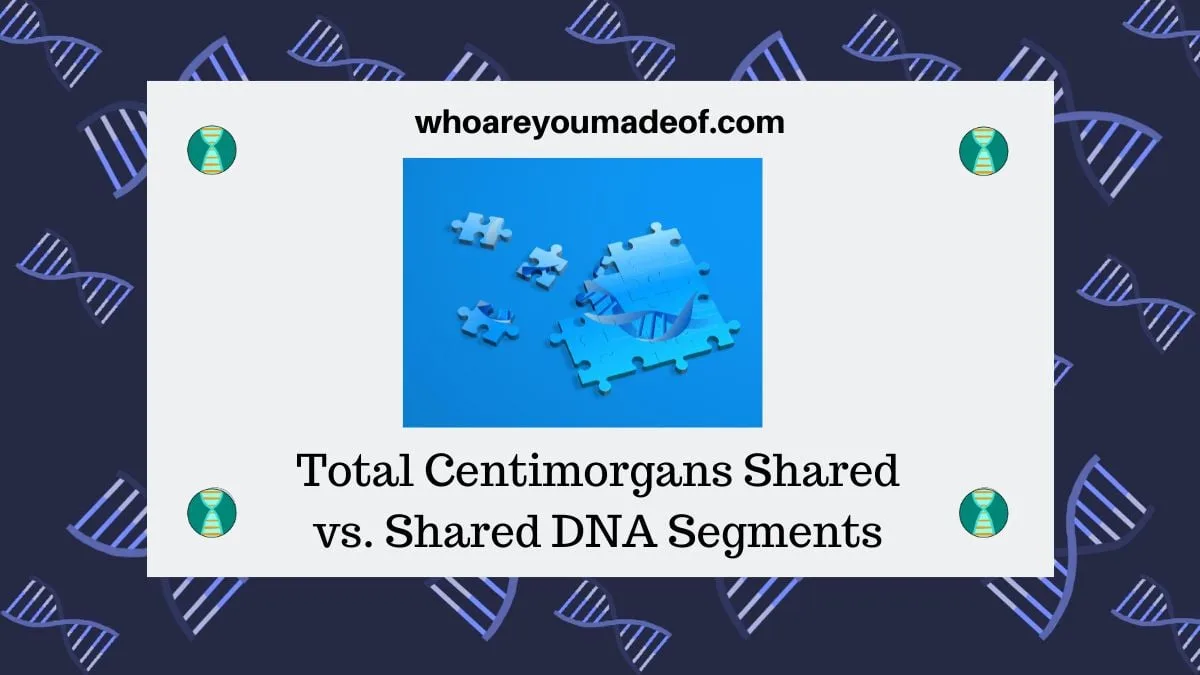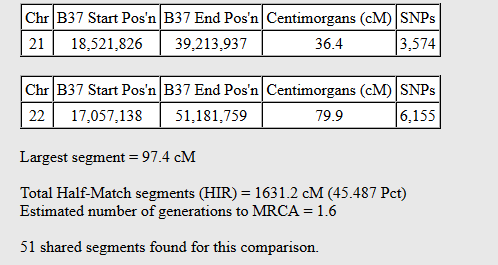If you have been examining your DNA match list, you might have noticed that there are a few different details related to the amount of shared DNA that you have with any particular match.
What is the difference between total centimorgans and the number of DNA segments that you and your match share?

Which bit of information is most important to figuring out how you and your match are connected? Does sharing more DNA segments mean that you are more closely related?
In this post, I'll answer those questions - and more!
Ancestry DNA customers might notice that they can only access the total number of shared segments, percentage of shared DNA, and total number of shared centimorgans. We can also see the size of the longest segment, but do not have access to any location data for shared DNA segments.
If you are interested in viewing this type of information, you might consider uploading your raw DNA information (which can be downloaded from Ancestry DNA) to another site that has a chromosome browser.
What is the difference between total centimorgans shared and shared DNA segments?
When autosomal DNA testing companies analyze our DNA, they compare positions in our genome to positions to those of their other customers in order to identify possible genetic matches.
When two people show up as a match, the testing company is able to measure a genetic distance between two points where the DNA is identical, and this is reported as a matching DNA segment.
It is possible to share only one DNA segment with someone, or more than a few dozen individual segments.
The sum of the genetic length of the DNA segments that you share with a match is reported as the total number of centimorgans (abbreviated as cMs) that you share. Companies usually only include DNA segments that are larger than a specific threshold, usually between about 5-7 cMs, in the calculation for total shared cMs.
There is a reason that the DNA testing companies typically do not count smaller shared segments. This is because the smaller the DNA segment, the higher the probability is that it is identical-by-state (coincidentally identical) vs. identical-by-descent (identical because it was inherited from a common ancestor).
In other words, the smaller the DNA segment, the higher the likelihood that it is a false segment.
Each company has a different threshold for how big a DNA should be to be included in the sum of total centimorgans shared, but it is typically somewhere between 5-7 cMs. In addition, some companies do count smaller segments when the amount of total shared DNA is over a certain threshold, since the probability of a genealogical relationship is higher.
The size and location of each DNA segment, as well as the total amount of shared DNA, can help you figure out how you and your DNA match are related. Additionally, if you and a known relative have both taken DNA tests, you can use the total centimorgans shared data to determine whether or not you share the expected amount of DNA for your relationship type.
Does sharing more segments mean two people are more closely related?
The number of DNA segments that we share with someone, considered with the size of said shared segments, can offer us clues to to how distantly we might be related, or whether or not we are likely to be related in more than one way.
With that said, there is no rule about how many segments you should share with a particular relative, and you can't come to any definitive conclusion about how you are related to someone based simply on the number of shared segments.
This means that, generally speaking, sharing more DNA segments with a match does not necessarily mean a closer relationship.
Endogamy affects number of shared DNA segments
If you are descended from a population where endogamy was prevelant, you might notice that you share many small DNA segments with your matches. In addition, you could share higher total amounts of shared centimorgans with matches, making it seem like they are more closely related than they are.
For example, if you share many small (under 15 cMs) segments with a match, it is possible - yet not guaranteed - that you might be related to that person distantly in more than one way.
This occurs frequently in communities that are descended from endogamous populations, such as Colonial Americans, Native Americans, French Canadians, or the European Jewish.
(Read: How to know if you have endogamy in your DNA matches)
Conversely, if you share only one long 50 cM segment with a match, there is a possibility that you are as closely related as second cousins, but also as distantly related as fourth cousins. However, a long shared segment doesn't always mean a recent ancestor.
Number of shared segments doesn't always provide relationship clues
Unfortunately, sharing many DNA segments with someone doesn't always mean that we are more closely related. For example, two full siblings will usually share fewer (and longer) DNA segments than half-siblings, yet are more closely related.
It would be amazing if there were some sort of key that we could create that would tell us how many DNA segments two people of a particular relationship distance should share, but unfortunately such a tool will probably never exist..
The most helpful thing that we can do to understand our genealogical relationship to our DNA matches. If you haven't yet started building a tree on Ancestry, now is a great time to start.
Does sharing more total centimorgans mean that two people are more closely related?
The total number of centimorgans that you share with a match usually is a good indicator of how closely you are related to someone. Even so, it's important to note that you can share many, many small DNA segments equaling a fairly high amount of total centimorgans.
Take, for example, the following image:

The person who took the Family Tree DNA test and Julie share a total of 201 centimorgans, but the longest segment is only 7 cMs in length. If I only looked at the 201 cMs figure, I might erroneously believe that Julie is a relatively close cousin of the person who gave the DNA sample.
Even Family Tree DNA suggests that they might be 2nd-3rd cousins! But, because the longest segment is only 7 cMs, I know that it is most likely that they are distant cousins in multiple ways, possibly sharing several common ancestors on different lines of their families.
Other times, I can be sure that the total amount of shared centimorgans is leading me in the right direction about the possible relationship between two people who have taken a DNA test.
The following image is a screenshot from the Gedmatch One-to-One comparison between two people who discovered that they are half-sisters:

As you can see, they share a large number of total centimorgans (1631 cMs). Not only that, the size of the largest segment is 97.4 cMs, which is very long.
It is almost impossible to share a DNA segment this long with someone and not have a fairly recent ancestor (in this case, a parent).
Total shared centimorgans and the size of the largest DNA segment is the most helpful information to determine your relationship to a match
We often need to take into account more than one data point to figure out our relationship with a match. The total shared centimorgans can sometimes be misleading, especially with more distant relatives.
To estimate our relationship to a match in these cases, we should take the following DNA details into consideration:
- Total shared centimorgans
- Number of DNA segments shared
- Size of the longest segment
While the total amount of shared centimorgans is generally more useful than the number of shared DNA segments, it is possible to share many small segments with a distant match, which is why the size of the longest segment is important.
A long DNA segment often indicates a more recent shared ancestor. This information is available on Ancestry, as well as the other major DNA testing sites.
Once you have a few potential relationships in mind, you can use additional information, such family tree details, to see if you can spot a connection.
Conclusion
I hope that this post has given you a better understanding about the difference between the total centimorgans shared, the number of shared DNA segments, and how to use this information to see how you might be related to your DNA match.
If you have any questions about something that you read in this post, or would like to ask a specific question about a DNA match that you have, I look forward to hearing from you in the discussion below.
Thanks for stopping by today!


Dot
Sunday 1st of January 2023
Hi.A match came up and can't understand if we are 1st cousins or half siblings.It would be on our fathers side.It was 20%DNA 1388cm across and 35 segments.We would love your thoughts on this.Thank you.
Liz
Tuesday 17th of May 2022
Thank you for your explanation of dna. I have a match with someone we match 298cm across 13 segments with longest being 75cm. Can you tell how close we might be related. Thanks for your help
Barbara Davidson Norkus
Wednesday 22nd of December 2021
So how can you identify a certain line, like my father's father's father, in my DNA. I have 3 kits in my immediate family girl+boy+boy siblings and an Uncle. I'm trying to connect to family of my ggf on my father's side. Matches are all over the place. Would love to hear your suggestions and ideas!
Mercedes
Thursday 6th of January 2022
Hi Barbara, Have you heard of the Leeds Method? This is a very simple way of clustering, or sorting, matches into likely family groups. Once this is done, you can examine family trees to do a bit of informal "triangulation" to determine the mostly likely shared ancestor between members of each group. Here are a couple posts that might help:
What is the Leeds Method? How to Cluster Your Ancestry DNA Matches How to Triangulate DNA Matches
M.c. H.
Wednesday 7th of April 2021
I uploaded data from a company that said they could provide ancient relatives, etc. One of the discoveries I made after I uploaded my information to this website was that it said I had ancient relatives in a part of a country in Europe; this website said that there were 18 SNP chains (min 60 SNPs) and it was 194 cm; this website said that I had 72% more cms than other users; I had a large chain of 235 SNPs and 26.41 cms. What does that mean? Does it mean my great, great, great, great, great great, great grandparents and I am related? Second, if I am related to this ancient group, and have so many cm's, wouldn't that appear in very modern DNA tests?
John Page
Monday 28th of September 2020
I'm told by one of the on line genealogy services that I have a DNA match as follows: 3rd-5th cousin, 0.5% (38.4? cM) Shared DNA, 1 shared segment, 38.4? cM Largest segment. I want to identify the person in my tree that is our common ancestor, or if that is impossible with the info provided, how far back in time or number of generations ago our common ancestor lived. Thanks much for your help. Regards, John